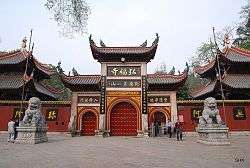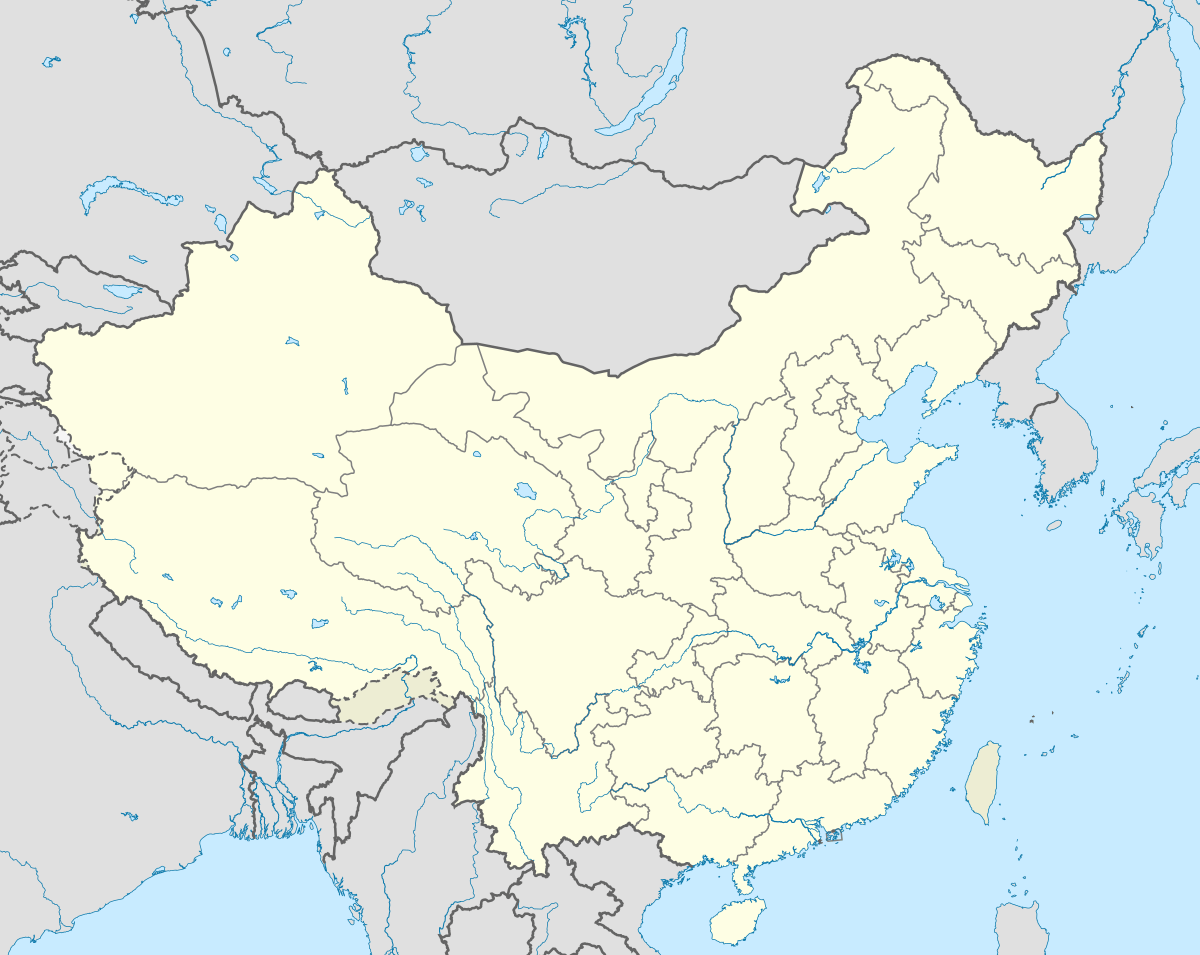Hongfu Temple (Guiyang)
Hongfu Temple (Chinese: 弘福寺; pinyin: Hóngfú Sì) is a Buddhist temple located on Mount Qianling, in Yunyan District of Guiyang, Guizhou, China. Hongfu Temple and Qixia Temple are collectively known as the "Two Attractions in Guiyang".
| Hongfu Temple | |
|---|---|
弘福寺 | |
 The Shanmen at Hongfu Temple. | |
| Religion | |
| Affiliation | Buddhism |
| Deity | Linji school |
| Leadership | Shi Xinzhao (释心照) |
| Location | |
| Location | Yunyan District, Guiyang, Guizhou |
| Country | China |
 Shown within China | |
| Geographic coordinates | 26°36′00″N 106°41′55″E |
| Architecture | |
| Style | Chinese architecture |
| Founder | Chisong (赤松) |
| Date established | 1672 |
| Completed | 1672 |
Name
"Hongfu" (弘福) in Chinese literally means developing Buddha’s spirit and benefiting the mankind.
History
The temple was originally built in 1672, eleventh year of the Kangxi Emperor, by monk Chisong (赤松), under the Qing dynasty (1644–1911). After the Parinirvana of Chisong, his disciple Zhai Mai (翟脉) succeeded the abbot. In 1739, in the 4th year of Qianlong period, the Qing government bestowed a set of Chinese Buddhist canon on the temple.[1][2]
In 1929, monk Guoyao (果瑶) founded the Guizhou Buddhist College in the temple.[2]
After the founding of the Communist State, master Huaiyi (怀一) served as abbot of Hongfu Temple.
During the ten-year Cultural Revolution, the temple was dilapidated with huge losses of the cultural relics.[2]
After the 3rd Plenary Session of the 11th Central Committee of the Chinese Communist Party in 1983, Hongfu Temple was designated as a National Key Buddhist Temple in Han Chinese Area by the State Council of China.[2]
On July 28, 1987, the government transferred the management rights to the temple.
Architecture
Now the existing main buildings include the Shanmen, Four Heavenly Kings Hall, Mahavira Hall, Hall of Guanyin, Hall of Maitreya, Buddhist Texts Library, and Pilu Pavilion (毗卢阁).
Shanmen
Under the eaves of the Shanmen is a plaque with the Chinese characters "Hongfu Temple" written by the former Venerable Master of the Buddhist Association of China Zhao Puchu. A pair of Chinese guardian lions stands on both sides of the Shanmen.
Bell tower
A biggest copper bell is stored in the Bell tower. The 1,500-kilogram (3,300 lb) copper bell was cast in 1469 during the mid-Ming dynasty (1368–1644).
Four Heavenly Kings Hall
Maitreya is enshrined in the Hall of Heavenly Kings. Four Heavenly Kings' statues are enshrined in the left and right side of the hall.
Hall of Guanyin
The statue of 32 Armed Guanyin is enshrined in the Hall of Guanyin, 32 arms represent 32 incarnation of Guanyin. At the back of Guanyin is a statue of Skanda.
Mahavira Hall
The Mahavira Hall enshrining the Three Saints of Hua-yan (华严三圣). In the middle is Sakyamuni, statues of Manjushri and Samantabhadra stand on the left and right sides of Sakyamuni's statue. In front of Sakyamuni stand Ananda and Kassapa Buddha on the left and right. The statues of Eighteen Arhats stand on both sides of the hall.
Jade Buddha Hall
The Jade Buddha Hall houses a sitting jade statue of Sakyamuni, which is 1.5-metre (4 ft 11 in) high, 1.2-metre (3 ft 11 in) wide and weighting 900-kilogram (2,000 lb). The statue came from Yangon, Myanmar.
References
- 探访黔灵山弘福寺 台媒体验贵州佛教文化. huaxia.com (in Chinese). 2015-07-23.
- 游在贵州佛教首刹弘福寺(图). sina (in Chinese). 2009-07-03.